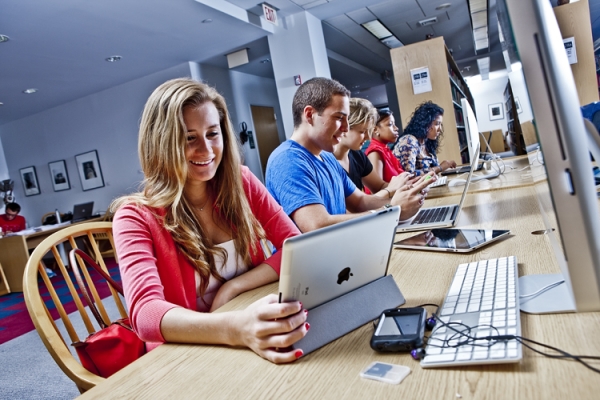We asked the world’s most innovative companies in education to school us on the future of the classroom, with predictions for the next five years.
Here's what we found out:
STUDENTS WILL INTERACT WITH OTHERS REMOTELY
Why do classrooms today look nearly identical to those 30 years ago—minus a few upgrades to the modern chalkboard, and sneaking texts in class instead of notes?
"With some exciting exceptions, public schools are one of the few institutions in modern life that have not seen radical changes spurred by technology," says Joe Williams, executive director of Democrats for Education Reform. "I’m not talking about having computers in classrooms, but rather a lack of any seismic shift in the way things are done because technology is making the work easier or more efficient."
Williams predicts that education tech will continue the push towards individualized instruction for students. Hadley Ferguson, executive director of the Edcamp Foundation, agrees: Kids can "reach out beyond the walls of their classrooms to interact with other students, other teachers, and renowned authors, scientists, and experts to enhance their learning," she says. Some of those digital-native kids will grow up to become teachers, who will continue to build and use their own communities of learning online.
THE SUCCESS OF TECH WILL STILL RELY ON SKILLED TEACHERS
We might be sending kids to school in self-driving cars by 2020, but that doesn’t mean they’ll be taught by teacher-avatars and given tests via drone.
"Education needs will drive technology use, rather than the ‘coolness’ of technology trumping education," predicts Shannon May, cofounder of Bridge International Academies. Instead of simply finding ways to put more tablets in kids’ hands, education technology will find new ways to supplement the best learning possible—regardless of the "coolness" of new tech.
Jake Schwartz, CEO and cofounder of General Assembly, predicts that as technology advances, its limits will become clear. "‘Online’ is not a cure-all for education issues in this country, but it can help provide greater access to new skills training," he says. "This is powerful when combined with curricula and programming created and led by practitioner educators. The human factor is always important."
WE’LL THINK DIFFERENTLY ABOUT THE DIPLOMA
The growing amount of the population living with crippling student debt combined with the pressure to keep tuition costs down threaten the sustainability of tuition-dependent institutions, says Schwartz.
"This will help to force an innovation drive with an unbundling of degree offerings," he says. "The sector will see a shift towards more relevant competency-based programs and aggressive competition for students." The education-employment gap will force higher educators to think creatively about how to offer the training students need for a workforce that desperately needs them.
May agrees: "Today, diplomas granted by years in school are the dominant certification of ‘learning.’ Yet, in almost all cases, these diplomas certify nothing other than the fact that the person in question spent x years in school. Competency-based certifications testing specific skills, and bundling individual skills into professional groupings will become a global currency for both employers and job seekers."
The possibilities offered in technology feed into this shift as well. "A new curriculum is going to be created that builds on these possibilities," says Ferguson, "allowing students to move away from rote learning and tackle real-world challenges and develop solutions for them."
STUDENTS WILL HAVE A VOICE
Kirsten Saenz Tobey, cofounder of Revolution Foods, sat down in a school cafeteria to do a little research. When she asked the kids how they felt about their meal options, one turned to her and said, "Does this look like it was prepared by someone who respects me?"
Students are ultimately their customers, Tobey says; if they don’t feel respected or listened to, they’ll never buy in to the healthier options her company is dishing out. But it’s not all chocolate cake and gummy worms: They’re launching a mobile app to give kids nutrition info, see the day’s menu, and give feedback on what they’re served.
Engaging and respecting students and families as wellness partners will become a new focus in ways we haven’t seen before, she says. "Traditional education is very top-down, heavy-handed—sit down and read, be quiet, don’t ask questions—there’s still a lot of room for innovation."
EDUCATORS AND INSTITUTIONS WILL BE FORCED TO ADAPT
As the above four factors change—a wider global reach, students who need to feel respected, and a workforce demanding skilled scholars—the roots of education will need to find ways to adapt.
To May, that means paying attention to our condensing, shifting world. By 2100, more than half the world’s population will live in India, China, or Africa. "Global policy leadership and sales of education goods and services will be shaped less by issues and needs in the U.S., and more by the issues and needs of Africa, South Asia, and China," May says. "Market demand, and pressing policy issues related to urbanization and population growth, will shift the center of gravity of education provision."
Put more simply, Tobey says, "We’re not quite stacking up to where the rest of the world is. [The U.S.] is feeling the pressure to be the world leader we think we are . . . particularly in math and science."
"For schools of all types, content or curriculum will not be the core differentiator, but rather they will be judged on how well they coordinate complex offerings into a useful package for their students and graduates," Schwartz says.
"Most professions can point to dramatic changes in the way they work, thanks to technological innovations, but teaching still looks and feels an awful lot like it did when today’s teachers were themselves students," says Williams. "It is starting to change, but it has been incredibly slow."


